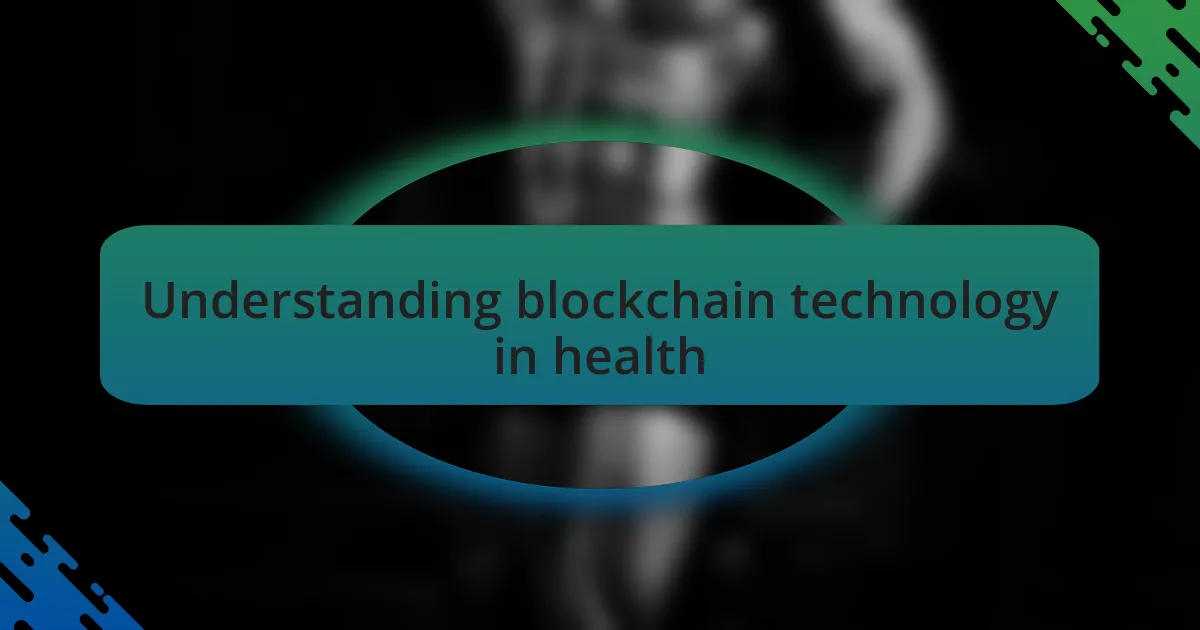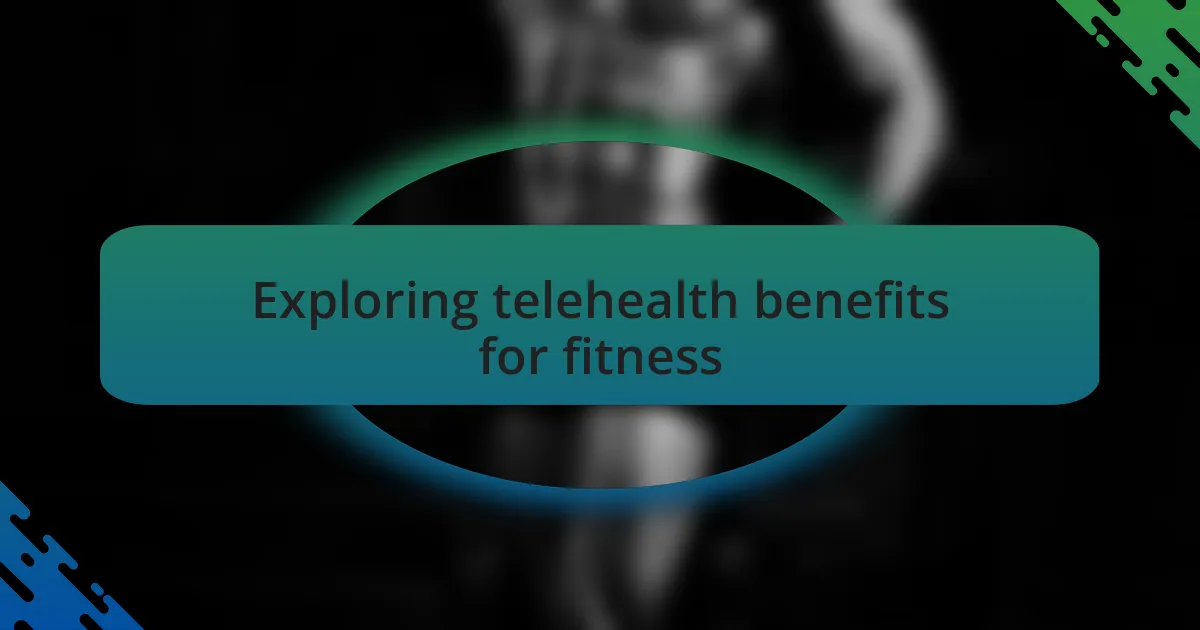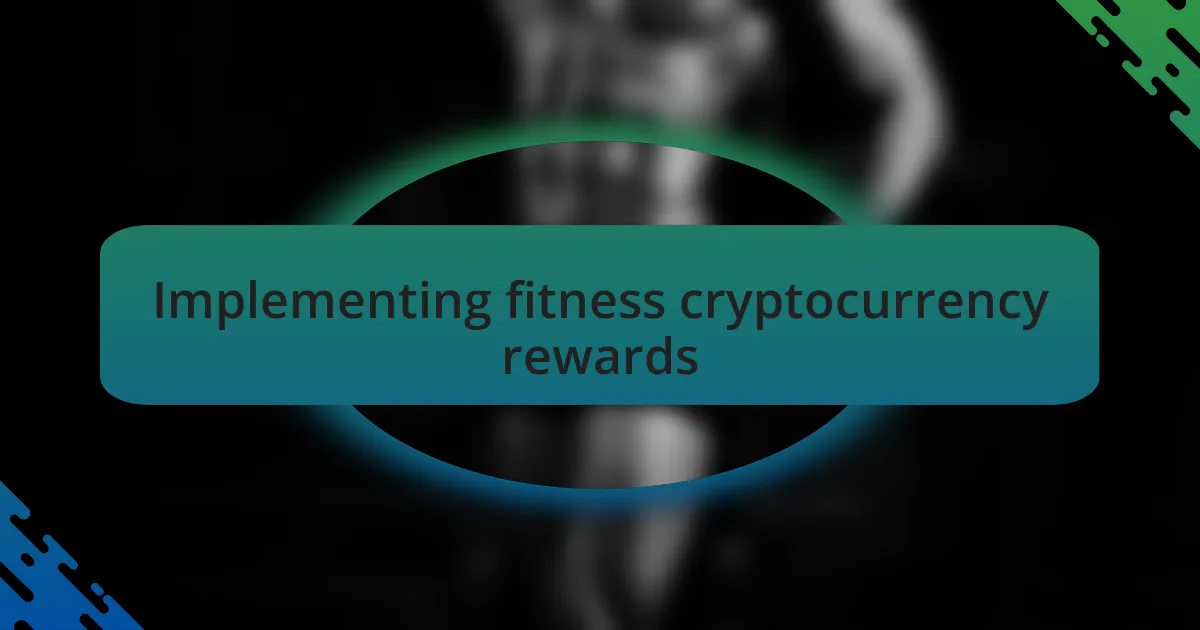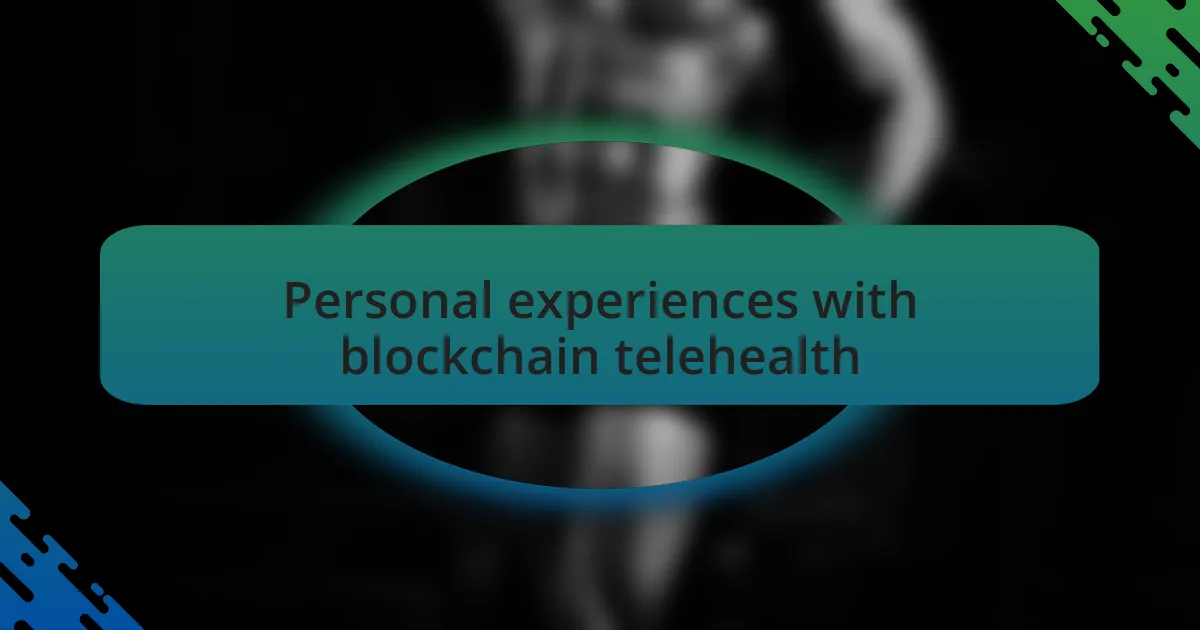Key takeaways:
- Blockchain technology enhances healthcare by providing secure, decentralized patient records, fostering trust and empowering patients.
- Telehealth improves fitness journeys by offering convenient access to expert guidance, real-time tracking, and specialized services.
- Cryptocurrency rewards incentivize physical activity, transforming workouts into opportunities to earn tangible rewards.
- Combining blockchain with telehealth improves data accuracy during virtual consultations and enhances patient control over personal health information.

Understanding blockchain technology in health
Blockchain technology is revolutionizing health by providing an immutable and decentralized way to store patient records. Imagine having complete control over your medical history, where each entry is secure and can be effortlessly shared with your healthcare providers. This level of transparency not only fosters trust but also empowers patients to take an active role in their own care.
When I first learned about blockchain’s potential in healthcare, I felt a wave of excitement. The thought of securely sharing my health data without intermediaries instantly resonated with me. How much easier would it be to have my medical information accessible across various platforms, without the fear of data breaches? This capability can drastically reduce duplication of tests and filings, streamlining treatment and reducing costs.
Moreover, the use of smart contracts in blockchain can simplify processes like insurance claims in health. From my perspective, automation through these contracts could eliminate tedious paperwork and discrepancies, allowing healthcare professionals to focus more on patient care rather than administrative hurdles. Why wouldn’t we want a more efficient, patient-centered system that prioritizes our well-being?

Exploring telehealth benefits for fitness
Telehealth can significantly enhance the fitness journey for individuals by providing convenient access to expert guidance and resources. I remember the first time I connected with a fitness coach through a telehealth platform; it felt like having a personal trainer right in my living room. This accessibility allows individuals to receive tailored advice without the hassle of traveling to an office, ultimately breaking down barriers to getting healthier.
Additionally, the integration of telehealth with fitness programs means real-time tracking and feedback on one’s progress. I often find that being able to share my workouts and health data directly with my trainer keeps me accountable and motivated. It’s intriguing to think about how direct communication via video calls can create a sense of community, making one feel supported in their fitness goals, even from afar.
Moreover, telehealth can offer specialized services such as nutritional counseling and mental wellness check-ins, which are crucial components of a holistic approach to fitness. I’ve found that discussing my mental health with a licensed professional has impacted my motivation levels in ways I never anticipated. Isn’t it fascinating how addressing our emotional and psychological well-being can directly enhance our physical fitness and overall health?

Introduction to cryptocurrency rewards
Cryptocurrency rewards are transforming the fitness landscape by offering participants a tangible incentive to stay active. I still remember when I first learned about platforms rewarding users with digital currencies for completing workouts. It was exciting to think that every time I smashed a fitness goal, I could earn something valuable, rather than just personal satisfaction. Doesn’t it make sense that we should get something in return for our hard work?
These rewards can take many forms, from tokens that can be traded for discounts on fitness gear to coins that hold real monetary value. I once earned a small stash of cryptocurrency just by logging my daily workouts; it felt like I was being rewarded for my commitment in a whole new way. It begs the question: if we can turn our fitness achievements into digital currency, could this change how we view exercise altogether?
Moreover, the integration of cryptocurrency with fitness apps has opened up new avenues for community engagement and motivation. I often find myself excited to join friendly competitions, driven not just by my desire to get fit, but also by the prospect of earning rewards. Isn’t it fascinating how this blend of technology and fitness can create such a vibrant culture, where we support each other while also capitalizing on our efforts?

How blockchain enhances telehealth solutions
Blockchain technology significantly enhances telehealth solutions by ensuring secure and transparent patient records. I remember discussing with a colleague how frustrating it is to deal with mismatched medical information during virtual consultations. With blockchain, every update to a patient’s medical history becomes a permanent record, safeguarding against errors and ensuring that both patients and providers have access to the most accurate data. Isn’t it reassuring to think that such security can lead to better healthcare decisions?
Furthermore, the potential for smart contracts in telehealth is something I find particularly exciting. These self-executing contracts can automate processes like insurance claims or payment for services rendered. I once experienced a delay in receiving a refund for an online consultation, which was stressful. With smart contracts, those delays can become a thing of the past, streamlining operations and enhancing the patient experience.
Lastly, blockchain fosters trust between patients and providers by giving individuals greater control over their personal health data. I recall one patient sharing their apprehension about sharing sensitive information during virtual visits. With blockchain, patients can grant and revoke access to their data at will, empowering them to feel secure in what they share. How empowering is it to hold the reins on one’s health information while still benefiting from cutting-edge telehealth services?

Implementing fitness cryptocurrency rewards
Implementing fitness cryptocurrency rewards can be a game-changer for motivation in personal health journeys. I remember when I first started tracking my workouts; the rewards seemed so far off. But when a fitness app introduced a cryptocurrency reward system, it completely transformed my perspective. Instead of viewing my workouts as just another chore, I began to see them as opportunities to earn something tangible—something that could have real-world value.
One key aspect to consider is how easy it is to integrate these rewards into existing fitness programs. I once participated in a challenge where every mile I ran translated into a specific amount of cryptocurrency. It felt great to see my progress marked not just in calories burned but in the digital currency I was accumulating. This not only motivated me to push my limits but also fostered a sense of community among participants eager to share their achievements. Who wouldn’t want to be part of something that celebrates personal milestones while incentivizing a healthier lifestyle?
Moreover, transparency is crucial in ensuring that users feel confident in these systems. In my experience, knowing the criteria for earning rewards helped me stay focused. It’s essential that fitness platforms clearly communicate how users can benefit from cryptocurrency, whether it’s through completing workouts, participating in challenges, or simply engaging with the community. With clear guidelines, it becomes easier to navigate the rewards landscape, making the entire experience more enjoyable and rewarding for everyone involved.

Personal experiences with blockchain telehealth
My journey with blockchain telehealth has been eye-opening. I never thought that a virtual consultation with my doctor would feel so personal, but the secure exchange of my health data through blockchain made me feel more connected. There’s something reassuring about knowing that my information is encrypted and only accessible to authorized professionals, which allowed me to focus entirely on my health rather than worry about privacy.
On one occasion, I used a blockchain-based app for a follow-up on my fitness goals after a recent injury. After the appointment, I was impressed by how easily my healthcare provider could access my previous records in real-time. I can still remember the relief I felt when my doctor quickly assessed my progress based on the up-to-date data, rather than relying on outdated notes. This seamless communication gave me confidence in my recovery plan, as I felt that my doctor was truly in tune with my journey.
In exploring these experiences, I’ve often wondered how blockchain can further enhance the telehealth landscape. For instance, I’d love to see more initiatives that incorporate fitness data into my health records for personalized recommendations. The ability to see trends in my workouts alongside my medical history could lead to even smarter, more tailored health interventions. It excites me to think about the future potential of these technologies and how they can revolutionize holistic health upon integrating fitness with healthcare.